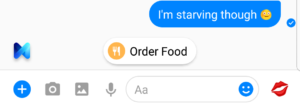Whenever we need something, a vast majority of us search it in Google or ask Siri. If we’re hungry, we usually ask Google or Siri to show us restaurants nearby. If we’re looking for something to do on the weekends, we turn to Google and Siri. Facebook Messenger is attempting to enter that personal assistant market with it’s M Suggestions. In 2015, M Suggestions was tested with a small user group in a Siri-like fashion. Those users would ask M to help them with things such as finding gifts or requesting rides. M used AI to fulfill those requests. If M didn’t know what to do, it routed the request to a human who would teach it how to handle those requests. M Suggestions relies on a combination of AI and humans in order to provide the most reliable service.
So what can it do?
 M Suggestions was rolled out to the American public in April 2017. However, it was rolled out in a very different form – we’ll call it M 2.0 for simplicity’s sake. M 2.0 scans conversations and provides its services whenever it thinks they are needed. For example, if I send “I’m starving though” to my friend, M 2.0 will give me the option to order food through the app. Messenger partnered with various websites such as Delivery.com to get these features embedded into the app. M 2.0 attempts to adapt to every user. I have noticed that since I never click on the pop-ups, M 2.0 has stopped suggesting them to me. Yet, whenever I want to use them, I can always click on the plus sign at the bottom left and M 2.0’s services will be made available to me.
M Suggestions was rolled out to the American public in April 2017. However, it was rolled out in a very different form – we’ll call it M 2.0 for simplicity’s sake. M 2.0 scans conversations and provides its services whenever it thinks they are needed. For example, if I send “I’m starving though” to my friend, M 2.0 will give me the option to order food through the app. Messenger partnered with various websites such as Delivery.com to get these features embedded into the app. M 2.0 attempts to adapt to every user. I have noticed that since I never click on the pop-ups, M 2.0 has stopped suggesting them to me. Yet, whenever I want to use them, I can always click on the plus sign at the bottom left and M 2.0’s services will be made available to me.
 M 2.0 can do a great deal of cool things like suggest payment options when your friend tells you that you owe them money. With this free service, Messenger is also competing directly with Venmo and PayPal. Currently, Messenger is not taking percentages of delivery orders or payment transactions in order to encourage network effects. Facebook’s main source of revenue is ad revenue. By keeping users on their apps, Facebook is increasing the revenue coming from each person. It’s making apps such as Yelp and PayPal obsolete and increasing the user’s average duration on their apps.
M 2.0 can do a great deal of cool things like suggest payment options when your friend tells you that you owe them money. With this free service, Messenger is also competing directly with Venmo and PayPal. Currently, Messenger is not taking percentages of delivery orders or payment transactions in order to encourage network effects. Facebook’s main source of revenue is ad revenue. By keeping users on their apps, Facebook is increasing the revenue coming from each person. It’s making apps such as Yelp and PayPal obsolete and increasing the user’s average duration on their apps.
In order to further increase user loyalty, M 2.0 has added other fun features. If someone messages you “goodbye”, M 2.0 can suggest gifs waving back. Essentially, the more you interact with M 2.0, the more suggestions it will offer. Those who love the service have the opportunity to use it more often while those who dislike it will eventually stop seeing the suggestions. Some users, though, might hate this pop-up service. Instead of waiting for M 2.0 to realize that you will not use it, you can easily turn it off by tapping on your image at the top right and scrolling to M Settings. (There you will also find the option of selecting a preferred car sharing service. Because Lyfts tend to be more expensive in my area, I had disabled M from suggesting Lyft rides.)
M Suggestions is, of course, Facebook’s latest attempt to monetize its products. Unlike its attempt to replace Snapchat, I think M 2.0 might actually be a success among my generation. What do you think? Would you use it?